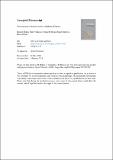Files in this item
Non-stationary Gaussian models with physical barriers
Item metadata
| dc.contributor.author | Bakka, Haakon | |
| dc.contributor.author | Vanhatalo, Jarno | |
| dc.contributor.author | Illian, Janine B. | |
| dc.contributor.author | Simpson, Daniel | |
| dc.contributor.author | Rue, Haavard | |
| dc.date.accessioned | 2020-01-18T00:34:47Z | |
| dc.date.available | 2020-01-18T00:34:47Z | |
| dc.date.issued | 2019-01-18 | |
| dc.identifier | 257463684 | |
| dc.identifier | 5baea21e-a264-4ca5-8fcf-6506e2c1906a | |
| dc.identifier | 85060491682 | |
| dc.identifier | 000460136700015 | |
| dc.identifier.citation | Bakka , H , Vanhatalo , J , Illian , J B , Simpson , D & Rue , H 2019 , ' Non-stationary Gaussian models with physical barriers ' , Spatial Statistics , vol. In press . https://doi.org/10.1016/j.spasta.2019.01.002 | en |
| dc.identifier.issn | 2211-6753 | |
| dc.identifier.other | RIS: urn:860E81DC76368D30E0C4659EDDBE58EE | |
| dc.identifier.uri | https://hdl.handle.net/10023/19307 | |
| dc.description | Data collection was funded by VELMU and the Natural Resources Institute Finland (Luke). | en |
| dc.description.abstract | The classical tools in spatial statistics are stationary models, like the Matérn field. However, in some applications there are boundaries, holes, or physical barriers in the study area, e.g. a coastline, and stationary models will inappropriately smooth over these features, requiring the use of a non-stationary model. We propose a new model, the Barrier model, which is different from the established methods as it is not based on the shortest distance around the physical barrier, nor on boundary conditions. The Barrier model is based on viewing the Matérn correlation, not as a correlation function on the shortest distance between two points, but as a collection of paths through a Simultaneous Autoregressive (SAR) model. We then manipulate these local dependencies to cut off paths that are crossing the physical barriers. To make the new SAR well behaved, we formulate it as a stochastic partial differential equation (SPDE) that can be discretised to represent the Gaussian field, with a sparse precision matrix that is automatically positive definite. The main advantage with the Barrier model is that the computational cost is the same as for the stationary model. The model is easy to use, and can deal with both sparse data and very complex barriers, as shown in an application in the Finnish Archipelago Sea. Additionally, the Barrier model is better at reconstructing the modified Horseshoe test function than the standard models used in R-INLA. | |
| dc.format.extent | 3996431 | |
| dc.language.iso | eng | |
| dc.relation.ispartof | Spatial Statistics | en |
| dc.subject | Archipelago | en |
| dc.subject | Barriers | en |
| dc.subject | Coastline problem | en |
| dc.subject | INLA | en |
| dc.subject | Spatial statistics | en |
| dc.subject | Stochastic partial differential equations | en |
| dc.subject | QA Mathematics | en |
| dc.subject | NDAS | en |
| dc.subject.lcc | QA | en |
| dc.title | Non-stationary Gaussian models with physical barriers | en |
| dc.type | Journal article | en |
| dc.contributor.institution | University of St Andrews. Statistics | en |
| dc.contributor.institution | University of St Andrews. Scottish Oceans Institute | en |
| dc.contributor.institution | University of St Andrews. Centre for Research into Ecological & Environmental Modelling | en |
| dc.identifier.doi | 10.1016/j.spasta.2019.01.002 | |
| dc.description.status | Peer reviewed | en |
| dc.date.embargoedUntil | 2020-01-18 |
This item appears in the following Collection(s)
Items in the St Andrews Research Repository are protected by copyright, with all rights reserved, unless otherwise indicated.

